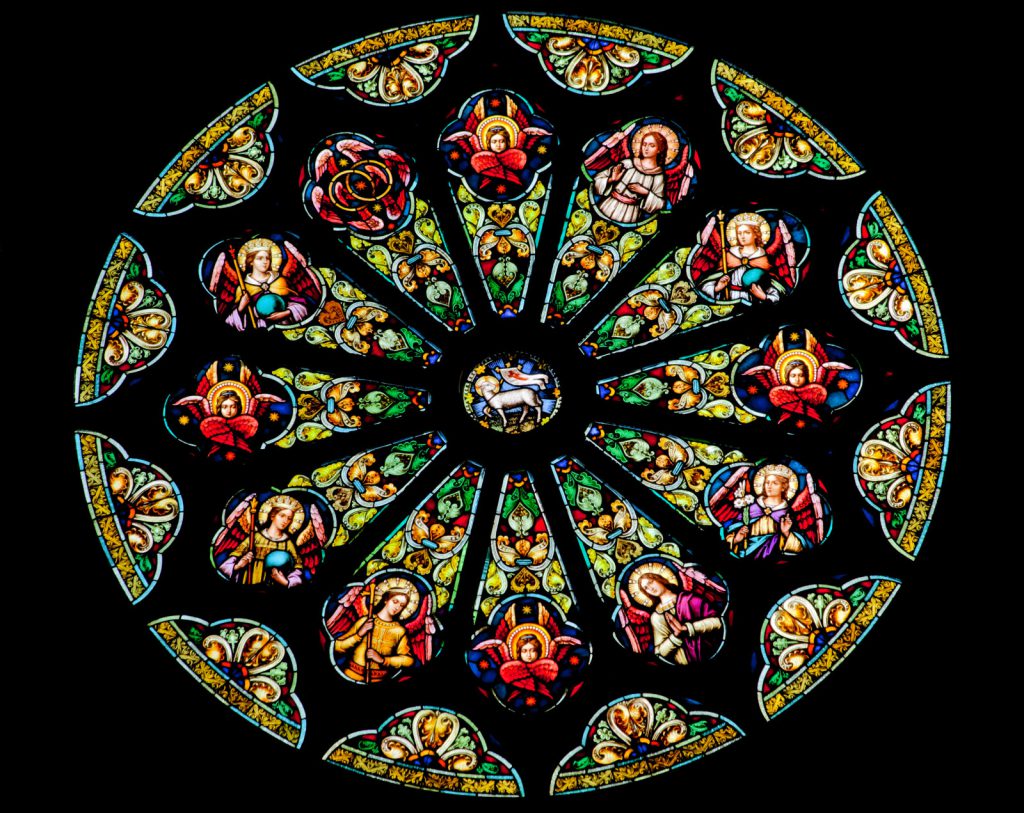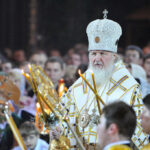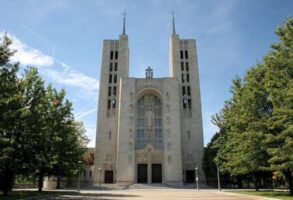
Published December 17, 2014
First Things, January 2015 issue
On November 19, 1964, the draft text of Vatican II’s Declaration on Religious Freedom was abruptly pulled from the floor of the council and a vote on it deferred for a year. The announcement of this unexpected decision, prompted by a request from Italian and Spanish bishops thought to be opposed to the Declaration, led to something approaching chaos. A petition to Pope Paul VI was hastily cobbled together and signed by hundreds of council fathers, asking the pope to permit a vote on the declaration before the council adjourned its third period in two days’ time. Paul VI determined that, despite the complaints of the majority, procedure had not been violated and the vote would be deferred until the council’s fourth period in the fall of 1965—at which point, Paul VI promised, the declaration would be the first item on the agenda.
Nothing like this legendary Black Thursday (which that patrician Latinist, John Courtney Murray, preferred to call the dies irae, the “day of wrath”) had been seen in the Catholic Church in the intervening fifty years until another Thursday: October 16, 2014, near the conclusion of the extraordinary synod on the family, convoked by Pope Francis to prepare an agenda for the ordinary synod on the family scheduled to meet in October 2015. (Synod 2015 will be “ordinary” because it’s one of the regularly scheduled synods that take place every three or four years.) The synod meeting last October, which involved presidents of national bishops’ conferences around the world and other senior Catholic officials, was indeed extraordinary, not least because, on October 16, the fathers of synod 2014 staged a mass revolt in the synod hall. There, amid another dramatic scene that included raised and angry voices, the fathers forced the synod leadership to release the full texts of the reports of their discussion groups (organized by language spoken), many of which had been highly critical of the “interim report” issued after the synod’s first week of plenary debate. That majority revolt, in turn, set in motion a process that led to a much modified, and considerably improved, final report from synod 2014.
In both these instances, the outbreak of very un-Roman behavior indicated that something serious was afoot, something that involved the very self-understanding of the Catholic Church. In 1964, the topic was religious freedom, but the deeper issues were the nature of the human person, the relationship between the rights of conscience and the claims of truth, the historic relationship of the Church to state power, and Catholicism’s evolving attitude toward political modernity. In 2014, the topic was the family and the Church’s pastoral response to the sexual revolution, but the underlying disputed questions were almost exactly the same, although this time they involved the Church’s relationship to postmodern culture more than its relationship to democracy and the separation of Church and state.
Alas, very little of that depth was apparent in the reporting and commentary on synod 2014, which was too frequently filtered through the narrative prism of “humane, progressive pope and his allies versus throwbacks to the party of intransigence at Vatican II.” That storyline, however, involves a misreading of Pope Francis, a misconception of the real issues engaged, a false portrait of the synod majority, a pattern of denial about the manipulations that marred the synod process, and a cartoonish caricature of those cast in the role of Bad Guys. Worst of all, it diverts attention from the grave matters Pope Francis quite correctly wished to bring to the fore: the crisis of marriage and the family throughout the West, and the challenge of linking truth and mercy in the pastoral care of those damaged in countless ways by this crisis.
Thanks to the passions aroused by the extraordinary synod itself and the confused and distorted reporting on it, there is going to be considerable air turbulence in the Catholic Church in the coming year. That turbulence might be abated, and some pastoral progress made, if the serious issues that underlie (and hinder) the Catholic Church’s attempts to wrestle with postmodern culture, especially its normalization and ideological justification of the sexual revolution, are seen for what they are. Only then can they be discussed in a calmer spirit than that which prevailed in Rome and around the world in mid-October 2014 and the weeks immediately following.
The German Problem. Pope Francis understands that there is a global crisis of marriage, as he made abundantly clear in a passionate address to the Schoenstatt movement the week after the synod concluded. There, he observed that marriage and family have never been so attacked as they are today, by a “throwaway culture” that reduces the covenant of marriage to a mere “association,” and against which the Church must propose “very clearly” the truth about marriage. It was always the pope’s intention that the 2014 extraordinary synod be a wide-ranging discussion of the crisis of marriage and the family. For he believes that only if the nature of the crisis is understood in full can the Church proceed to think about how it can propose its understanding of marriage in ways that can be more readily heard and lived in today’s Gnostic culture. That thorough examination of the crisis, and the celebration of Christian marriage as the answer to it, didn’t happen to the degree one might have hoped. And that was in no small part the doing of German bishops led by retired Cardinal Walter Kasper, in league with the synod general secretary, Cardinal Lorenzo Baldisseri, who seemed determined to push the question of Holy Communion for divorced and civilly remarried Catholics to the front of the line in the synod’s debates.
The German fixation on this issue was in one sense an expression of self-absorption with the pastoral problems of a sclerotic German Church, which are indisputably grave. In another sense, however, the “Communion ban” issue (as it was vulgarly described in the press) is a stalking horse for a much larger argument about the nature of doctrine and its development. And this, in turn, reprises the long-running debate over the meaning of Vatican II and its relationship to Catholic tradition that Kasper and his allies seem determined to reopen.
Ten months before the synod met, I asked a knowledgeable observer of German Catholic affairs why the German Catholic leadership insisted on revisiting the issue of Holy Communion for those in civil second marriages, which most of the rest of the world Church thought had been sufficiently aired in the 1980 synod on the family, and which seemed to have been settled by the reaffirmation of the Church’s traditional teaching and practice in
St. John Paul II’s 1981 apostolic exhortation Familiaris Consortio (The Community of the Family) and in the 1983 code of canon law. I got a one-word answer: “money.”
The German Church is funded by the Kirchensteuer, the “church tax” collected by the Federal Republic from every citizen who has not taken action to opt out of it. The funds involved are considerable; in 2011, the Kirchensteuer provided the Catholic Church in Germany with $6.3 billion. Recently, however, more and more German Catholics have been choosing to opt out. In a clumsy attempt to stanch the bleeding, the German bishops issued a decree in 2012, stating that anyone who opts out of the tax has “left the Church” and that such de facto apostates are cut off from the Church’s sacramental life, except in danger of death. The decree was widely mocked and German canonists declared it a nonstarter, for it takes more to “leave the Church” than signing a civil affidavit. In any event, payment of the Kirchensteuer has continued to drop.
Many German bishops seem to have concluded that this pattern of defection from payment of the Church tax can best be explained by the perception of the Catholic Church as a mean, narrow, and cruel exponent of propositions—such as the indissolubility of marriage—that no self-respecting twenty-first-century European can accept. That people have stopped paying the Kirchensteuerbecause they have stopped believing that Jesus is Lord and that the Catholic Church is his Body might seem the more straightforward explanation. But adopting that interpretation would require acknowledging that the meltdown of Catholic faith and practice in Germany has had something to do with the colossal failures of German theology and catechetics to transmit the Gospel effectively under the challenging conditions of late modernity and postmodernity. And that, to borrow an image from another battle, seems a bridge too far.
Prior to the synod, extensive critiques of Cardinal Kasper’s proposals for allowing divorced Catholics in civil second marriages to be restored to the Church’s full eucharistic communion were published in the theological quarterly Nova et Vetera and in a book of essays, Remaining in the Truth of Christ: Marriage and Communion in the Catholic Church, whose authors included five scholar-cardinals. In both cases, the responses to the Kasper proposals were academically serious and respectful in tone. Yet Kasper, in replying to his critics (primarily in press interviews), failed to sustain the debate at the level of seriousness it deserved, dismissing those who had found grave biblical, patristic, theological, canonical, and pastoral problems with his proposals as doctrinal and scriptural fundamentalists.
During the synod itself, Cardinal Kasper gave a lecture in Vienna, in which he located his position on marriage and the family within his understanding of Vatican II as a council that had opened a new era in Catholic life, one in which all the old verities are now subject to reexamination, and perhaps even reconsideration. Here, too, one wonders just what information has been reaching Germany in recent decades. The vibrant parts of Catholicism in the developed world are those that have lived the dynamic orthodoxy displayed in the teaching of John Paul II and Benedict XVI; the crumbling parts of European Catholicism—which is to say, most of western European Catholicism—are those that have bent to the winds of the zeitgeist and have fudged the Church’s doctrinal and moral boundaries, imagining that to be the “spirit of Vatican II.” Yet there was Kasper, in league with synod general secretary Baldisseri, promoting a further fudging of the boundaries, and doing so in ways that seemed to the majority of synod fathers (the media spin notwithstanding) to be in flat contradiction to the teaching of the Lord himself.
Thirteen years ago, Cardinal Joachim Meisner, then the archbishop of Cologne, told me that the greatest resource German Catholicism has for rebuilding itself in the twenty-first century is the witness of its twentieth-century martyrs. The spiritual power of principled resistance is something that German theologians, bishops, and theologian-bishops (and their fellow travelers) might ponder in the months preceding synod 2015. Acquiescence, followed by surrender, followed by collaboration: that was the disturbing sequence followed by too much of European Catholicism during the Church’s contest with the mid-twentieth-century totalitarianisms in Germany and Italy and with their allies in France. The martyrs chose a different way. The path suggested by their countercultural witness surely deserves consideration as Catholicism tries to implement Pope Francis’s vision of a “Church in permanent mission” in the face of aggressive secularism and its erosion of marriage and the family.
Africa’s Moment. Not surprisingly, the proposals pressed by the Germans and their allies at synod 2014 were presented in much of the mainstream media as something bold, fresh, and innovative, when in fact they were rather stale and shopworn, remnants of a vision of “progressive” Catholicism that had, by any evangelical criterion, manifestly failed in Europe and elsewhere. What was new at the extraordinary synod—and what helped make it “extraordinary” in the ordinary sense of that word—was the emergence of African Catholicism as a major factor in shaping the future of global Catholicism. African synod fathers were among the leaders in challenging the Kasper proposals, arguing forcefully that the Christian idea of marriage had come to their cultures as a liberating force, especially for women. They also suggested, implicitly if not explicitly, that bishops representing dying local churches ought not be exporting Western decadence to the Global South, where Catholicism was growing exponentially by preaching the truths of the Gospel with compassion but also without compromise.
This took courage, and not only because it exposed the Africans to charges of being culturally backward (or, as Cardinal Kasper inelegantly put it, of being in thrall to “taboos”). It also took courage because a lot of the Church in Africa is paid for by German Catholic development agencies, which are extraordinarily well off and quite generous, thanks to the Kirchensteuer. Yet it seemed to men like Cardinal Wilfrid Fox Napier, the Franciscan archbishop of Durban long thought to be aligned with the Catholic left, that something of exceptional importance was at stake in the synod’s discussion of both marriage and the pastoral care of those with same-sex attraction. Thus Napier and others thought it time to blow the whistle, which Napier did with a remarkable denunciation of the synod’s interim report (and its leak to the press)—a courageous call that effectively gave permission for others to say what they really thought about the manipulations of the synod’s discussion that were openly displayed in that report.
The Process. Throughout the synod, concerns that synod process was being manipulated by the general secretary, Cardinal Baldisseri, in league with Archbishop Bruno Forte, the Italian theologian who was the synod’s special secretary, were routinely dismissed as conservative conspiracy-mongering, even by typically sensible Vaticanisti (and there are a few). That was not the tale told by numerous synod fathers, however, and it was clearly their frustrations with the process that led to the blowup of October 16 and the subsequent release of the reports of the debates in the synod’s language-based discussion groups, which revealed sharp and extensive disagreement with the line taken in the interim report prepared by Forte.
What was defective with the process? Numerous things. The pope had called, appropriately, for an open and freewheeling debate, which was not altogether characteristic of Catholicism’s experience of synods since the institution was established during Vatican II. But the synod secretariat declined to release the texts of the synod fathers’ interventions during the first week when the fathers, auditors, and observers spoke to the entire assembly. Summaries of the debates released by the Vatican Information Service (presumably under the direction of the synod secretariat) and more than a few of the synod’s daily press conferences were criticized for being exercises in spin rather than accurate renderings of the breadth of the discussion. Those who suggested that more-honest reporting was in order were slapped down, and more than a few synod fathers came to the conclusion that, as one put it, manipulation of the proceedings was both “manifest and inept,” in the sense of being both obvious and, so to speak, stupidly obvious.
But it was Forte’s interim report that really put iron into the spines of many synod fathers. That report was supposed to be a snapshot of the principal themes of the first week’s debates in the general synod assembly, which were to be further explored and refined in the language-based discussion groups during the synod’s second week. But Forte crafted it as a draft final synod document, highlighting issues that would be of greatest interest to an international media eagerly awaiting the Great Catholic Cave-In to the sexual revolution—and found himself, and the interim report, essentially disowned by Cardinal Péter Erdő, the synod’s relator (or official summarizer), at the press conference at which the interim report was presented.
As one language-based discussion group began its deliberations, one member asked the others, with respect to the Forte-crafted interim report’s language on pastoral approaches to persons with same-sex attraction, “Did you hear any of this last week?” He got a unanimous negative reply. The interim report’s adoption of the language of the LGBT insurgency also came in for serious criticism, with synod fathers insisting that the Catholic Church does not describe human beings by their desires, whatever they are, and that doing so contradicts the rich Catholic anthropology of the human person, most recently articulated by John Paul II in his inaugural encyclical, Redemptor Hominis, and in his theology of the body.
Which in turn raised another question about the synod process: Why were no faculty members of the Pontifical John Paul II Institute on Marriage and the Family invited as auditors or observers of the synod? The institute’s home base is the pope’s own Roman university, the Lateran; it has faculties around the world; Stanisław Grygiel, the Institute’s founding director, and his wife, Ludmilla, had given magnificent papers on the Christian idea of marriage at a European conference on family matters shortly before the synod. But the Grygiels were not invited to the synod, nor was the distinguished moral theologian who is now the Rome institute’s director, Msgr. Livio Melina. Given the ways of the Vatican, this could not have been an accidental omission. It seems far more likely that it was a deliberate decision by the synod’s general secretary, Cardinal Baldisseri, who was presumably uninterested in having the Kasper approach and the Kasper proposals challenged by the magisterium of John Paul II—even though that magisterium had shown itself over the past two decades to have been the Church’s most successful response to the sexual revolution and the severe collateral damage that upheaval had done to marriage and the family.
This mistake can easily be repaired in the run-up to the ordinary synod of 2015. The deliberations of that larger assembly (which will include more bishops than the extraordinary synod) would greatly benefit from the experience of the John Paul II Institute faculty. For they (and others also uninvited to synod 2014) have advanced an integral Catholic anthropology that meets the assault of the sexual revolution, not by acquiescing to it, but by challenging it to a debate over who takes human sexuality more seriously: those who see in faithful and fruitful married love an icon of the interior life of the Trinity, or those who reduce sex to another contact sport?
What will not be so easy to repair, and may be, as Cardinal Napier suggested, “irreparable,” is the damage done by Archbishop Forte’s interim report. Attempts by Cardinal Baldisseri and others to explain the report away as a mere report card on discussion themes are belied by two facts. First, the interim report was severely criticized in at least seven of the ten language-based discussion groups in the synod’s second week, where it was regarded as an inaccurate rendering of the synod’s discussions. Second, very little of what the Catholic left and the world press found revolutionary and agreeable in the interim Report was to be found in the synod’s final report, which Pope Francis has declared the agenda-setting document for synod 2015, or in the synod’s “Message” to the world, a well-crafted document celebrating marriage and the family.
Yet given the media sequence here—the interim report was leaked before it was formally presented (not accidentally, one presumes), and so the media template was quickly set in concrete (“It’s finally happened! The Church is changing!”)—what the world knows about synod 2014 is largely the interim report. This means that the stock “narrative”—kindly pope and progressives battle pre–Vatican II meanies—will be carried forward by much of the press. And that is going to distort and impede the important conversation that the pope rightly wants the world Church to have between synod 2014 and synod 2015.
A Success? In his closing address to the synod, Pope Francis declared the synod a success—which it was, if not precisely in the way the synod minority (the supporters of the Kasper proposals and the Forte interim report) have subsequently claimed. A robust debate was held in spite of the difficult circumstances created by the synod general secretariat. Out of that debate emerged a clear consensus in favor of the Catholic Church’s classic teaching on the nature of the human person, the morality of love, the nature of marriage, and the need to combine truth and mercy in proclaiming what John Paul II called the Gospel of life. Pastors who have been clumsy or cruel in dealing with couples in irregular marriages or with those experiencing same-sex attraction—a distinct minority, in my experience—have been reminded that the Good Shepherd remains the model of pastoral charity in the Church.
Africa has been a vital center of Catholic life and Catholic witness for decades, and that vitality and witness is now in play at the highest levels of the Church’s deliberations. The pope’s call for openness, and the confidence the African bishops have in the truth of their own ecclesial experience, has empowered them to resist suggestions that they defer to their European betters.
And while a lot of the reporting and commentary on the synod fell back into the bad habit of portraying all Catholic debates in the hoary categories of Good Progressive and Bad Conservative, a closer examination of the debates makes it clear that the drama of the Catholic Church in the twenty-first century is not unfolding according to the playbook detailed in the now half-century-oldNew Yorker articles by the pseudonymous “Xavier Rynne,” who crafted the cowboys-and-Indians clichés that still guide too much mainstream media coverage of matters Catholic. The dynamic and orthodox leaders of the Church today—the men who successfully foiled the attempt to divert synod 2014 down the path charted by the interim report, and whose interventions accounted for the much improved final report and the synod’s “Message” to the world—are all men of Vatican II, not menagainst Vatican II. They read the council through the magisterium of John Paul II and Benedict XVI, which they see as offering an authoritative interpretation of its teaching. They want that authoritative interpretation deployed in service to what John Paul II called the new evangelization—which Pope Francis, in the 2013 apostolic exhortation Evangelii Gaudium, has made the grand strategy of his own pontificate. They know that the new evangelization is not advanced by tactical, and still less by strategic, compromises with the zeitgeist on the indissolubility of marriage and the morality of human love. And they are not prepared to take instructions on how to advance the new evangelization from Catholic leaders in Germany, Italy, England, or elsewhere who have manifestly failed in their evangelical task.
Still, there is a lot of work to do in response to Pope Francis’s call for the entire Church to continue the discussions begun in October 2014. The key issues to be addressed in the coming months as the Church prepares for synod 2015 include at least the following:
The Church’s discussion over the next year, and its interaction with the culture on the issues of marriage and the family, should be more data-driven than anecdotal. More data should be brought forward—and they are abundantly available—to demonstrate that the Church’s idea of permanent and fruitful marriage, like the Church’s teaching on the appropriate means of regulating fertility, makes for happier marriages, happier families, happier children, and more-benevolent societies than does the deconstruction of marriage and the family that is inundating the West like a tsunami. In teaching the truth about marriage, about love, and about the complementarity of the sexes, the Catholic Church is proposing the path to happiness and human flourishing, not the road to repression and misery. It should make a bold, data-driven case in defense of that teaching, which is a defense of the dignity of the human person.
At the same time, the Church should engage in a much more serious discussion about the “ladder of love,” an image for the spiritual life that St. Augustine adopted from Plato’s Symposium. At the synod, it was suggested that, as a matter of pastoral strategy, the Church should approach people “where they are” on that ladder of love, no matter how low the rung. That’s certainly true, and indeed always has been true. But the Church approaches people “where they are” on the ladder in order to invite them to climb higher, with the help of God’s grace mediated through the Church’s sacraments. Finding worthy elements in irregular marital situations or irregular sexual relationships is not a matter of endorsing those irregularities, but of inviting people to ascend the ladder. This means helping them understand the fullness of the good and encouraging them to seek it, with the help of grace. The challenge here is as old as Paul’s efforts on the Areopagus, and it is not going to go away. But discussion of how to invite men and women to climb higher on the ladder of love will not be advanced by appeals to compassion that effectively detach compassion from truth, or by accommodating contemporary shibboleths about sexuality in any of its expressions.
One of the standard media tropes of synod 2014 coverage, too often drawn from unfortunate comments by synod fathers, was the difference between “doctrine” and “pastoral practice.” The two are obviously not the same. But it is just as obvious that certain ecclesial practices, such as defining the conditions that constitute (or impede) worthiness to receive Holy Communion, are closely linked to settled doctrine: the doctrine, drawn from the Lord himself, that marriage is indissoluble, and the implication of that doctrine for the proper reception of Holy Communion, which is drawn from St. Paul: Whoever “eats the bread or drinks the cup of the Lord in an unworthy manner will be guilty of profaning the body and blood of the Lord” (1 Cor. 11:27).
Now that it is abundantly clear (to everyone except Cardinal Kasper, it seems) that there is no consensus possible in favor of the Kasper proposals for changing the Church’s practice in this matter (because doing so would constitute an impossible change in doctrine), the discussion over the next year should focus on adjustments of the canonical processes by which marriages are judged null, and on the truths about the Holy Eucharist and the sacrament of penance that are at the root of the Church’s current—and future—understanding and practice concerning worthiness to receive Holy Communion. For all their faults—indeed, because of their faults and the media attention they received—the Kasper proposals afford pastors and bishops a remarkable opportunity to recatechize (or, in many instances, catechize) their people about marriage, the Eucharist, and penance. Pastoral letters on these subjects would be helpful, but nothing is more important here than effective preaching.
The synod’s final report raised a strong protest about “pressure” being exerted on “the pastors of the Church” by cultural, political, and legal forces advancing the LGBT agenda, and rejected as “totally unacceptable” the machinations of “international organizations who link financial assistance to poorer countries with the introduction of laws which establish ‘marriage’ between persons of the same sex.” That was useful pushback against the agenda of the U.S. Agency for International Development and the Obama State Department, among others. Discussion of these “pressures” before synod 2015 affords the Church’s pastors another opportunity to clarify for the Church’s people the essential difference between the sacramental covenant of marriage, on the one hand, and the civil contract of a private sexual relationship that is accorded public legal recognition by the state, on the other. That clarification should lead, in turn, to a thorough reexamination of the Church’s relationship to civil marriage, centered on the question of how the Church might avoid complicity in the fraud of “same-sex marriage.” Does the Church damage the credibility of its teaching within the household of faith, and weaken its witness in the public square, when Catholic deacons, priests, and bishops sign state marriage licenses that designate “spouse 1” and “spouse 2”? Such euphemisms signal an understanding of marriage that is not simply different from, but intrinsically opposed to, the Church’s understanding. These discussions might also benefit by being framed within a richer ecclesiology than was often evident in the debates at synod 2014, with the ancient concept of the family as the ecclesiola, the “little Church,” at the center of reflection on the relationship between the domestic Church and the mystical body of Christ.
No one who had suffered through the tedium of previous synods could have objected to Pope Francis’s determination to enliven the process and foster an open, frank discussion of issues of concern. That noble intention will be advanced if synod 2015 is run in a very different manner from that of synod 2014. This may require certain adjustments in the senior personnel of the synod general secretariat, but the basic change needed is one of attitude. The synod secretariat must understand that it exists to serve the synod fathers, not to manipulate the process and drive the discussion down a path toward certain predetermined conclusions. The massive resistance demonstrated by the synod fathers on October 16 to exactly that kind of manipulation was, in fact, a very healthy development in the still-young tradition of regular church-wide synods, for it demonstrated that the bishops took quite seriously the pope’s call for a reclamation of synodality and collegiality. The fairness of the synod process, in other words, is a worthy subject of discussion between now and synod 2015, and that discussion in no sense constitutes a criticism of Pope Francis; on the contrary, it is in service to his vision of what synods could and should be.
Finally, this entire discussion of the crisis of marriage and the family in the twenty-first century should be more closely and explicitly linked to the new evangelization. Men and women in the various marriage-preparation and campus ministries that have enjoyed real success in deploying the theology of the body and other post-conciliar Catholic theological and pastoral developments to the challenging tasks of evangelization and catechesis in hostile cultural environments should be invited to synod 2015 as auditors and observers. Their practical pastoral experience would enhance the theoretical insights that faculty from the John Paul II Institutes on Marriage and the Family could bring to synod 2015.
The ordinary synod of 2015, in other words, ought to reflect more clearly the three concerns that Pope Francis expressed in his closing address to synod 2014: a passionate concern for mission, a compassionate concern for people in difficult situations, and a committed concern for the settled truths of the Catholic faith. Holding those three concerns together at once may be challenging. But that is the challenge of this particular Catholic moment. Meeting it will be a service to the evangelization of a broken and suffering world, which is the Church’s primary mission.
— George Weigel is Distinguished Senior Fellow of Washington, D.C.’s Ethics and Public Policy Center, where he holds the William E. Simon Chair in Catholic Studies.











